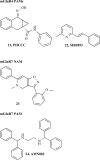Allosteric modulators for mGlu receptors
- PMID: 19305801
- PMCID: PMC2656819
- DOI: 10.2174/157015907781695900
Allosteric modulators for mGlu receptors
Abstract
The metabotropic glutamate receptor family comprises eight subtypes (mGlu1-8) of G-protein coupled receptors. mGlu receptors have a large extracellular domain which acts as recognition domain for the natural agonist glutamate. In contrast to the ionotropic glutamate receptors which mediate the fast excitatory neurotransmission, mGlu receptors have been shown to play a more modulatory role and have been proposed as alternative targets for pharmacological interventions. The potential use of mGluRs as drug targets for various nervous system pathologies such as anxiety, depression, schizophrenia, pain or Parkinson's disease has triggered an intense search for subtype selective modulators and resulted in the identification of numerous novel pharmacological agents capable to modulate the receptor activity through an interaction at an allosteric site located in the transmembrane domain. The present review presents the most recent developments in the identification and the characterization of allosteric modulators for the mGlu receptors.
Figures
Similar articles
-
Pharmacology of metabotropic glutamate receptor allosteric modulators: structural basis and therapeutic potential for CNS disorders.Prog Mol Biol Transl Sci. 2013;115:61-121. doi: 10.1016/B978-0-12-394587-7.00002-6. Prog Mol Biol Transl Sci. 2013. PMID: 23415092 Review.
-
Allosteric modulation of metabotropic glutamate receptors.Adv Pharmacol. 2011;62:37-77. doi: 10.1016/B978-0-12-385952-5.00010-5. Adv Pharmacol. 2011. PMID: 21907906 Free PMC article. Review.
-
Metabotropic glutamate mGlu1 receptor stimulation and blockade: therapeutic opportunities in psychiatric illness.Eur J Pharmacol. 2010 Aug 10;639(1-3):2-16. doi: 10.1016/j.ejphar.2009.12.043. Epub 2010 Apr 2. Eur J Pharmacol. 2010. PMID: 20371230 Review.
-
Allosteric modulators of group I metabotropic glutamate receptors: novel subtype-selective ligands and therapeutic perspectives.Curr Opin Pharmacol. 2002 Feb;2(1):43-9. doi: 10.1016/s1471-4892(01)00119-9. Curr Opin Pharmacol. 2002. PMID: 11786307 Review.
-
Metabotropic glutamate receptors as therapeutic targets in Parkinson's disease: An update from the last 5 years of research.Neuropharmacology. 2017 Mar 15;115:166-179. doi: 10.1016/j.neuropharm.2016.03.036. Epub 2016 Apr 4. Neuropharmacology. 2017. PMID: 27055772 Review.
Cited by
-
Allosteric Molecular Switches in Metabotropic Glutamate Receptors.ChemMedChem. 2021 Jan 8;16(1):81-93. doi: 10.1002/cmdc.202000444. Epub 2020 Aug 25. ChemMedChem. 2021. PMID: 32686363 Free PMC article. Review.
-
Aberrant glutamatergic systems underlying impulsive behaviors: Insights from clinical and preclinical research.Prog Neuropsychopharmacol Biol Psychiatry. 2024 Dec 20;135:111107. doi: 10.1016/j.pnpbp.2024.111107. Epub 2024 Aug 2. Prog Neuropsychopharmacol Biol Psychiatry. 2024. PMID: 39098647 Review.
-
Positive allosteric modulators of metabotropic glutamate 2 receptors in schizophrenia treatment.Trends Neurosci. 2015 Aug;38(8):506-16. doi: 10.1016/j.tins.2015.06.002. Epub 2015 Jul 4. Trends Neurosci. 2015. PMID: 26148747 Free PMC article. Review.
-
Structures of metabotropic GABAB receptor.Nature. 2020 Aug;584(7820):310-314. doi: 10.1038/s41586-020-2469-4. Epub 2020 Jun 24. Nature. 2020. PMID: 32580208 Free PMC article.
-
Silent Allosteric Modulation of mGluR5 Maintains Glutamate Signaling while Rescuing Alzheimer's Mouse Phenotypes.Cell Rep. 2017 Jul 5;20(1):76-88. doi: 10.1016/j.celrep.2017.06.023. Cell Rep. 2017. PMID: 28683325 Free PMC article.
References
-
- Annoura H, Fukunaga A, Uesugi M, Tatsuoka T, Horikawa Y. A novel classof antagonists for metabotropic glutamate receptors, 7-(hydroxyimino)cyclopropachromen-1a-carboxylates. Bioorg. Med. Chem. Lett. 1996;6:763–766.
-
- Bergink V, Westenberg HG. Metabotropic glutamate II receptor agonists in panic disorder: a double blind clinical trial with LY354740. Int. Clin. Psychopharmacol. 2005;20:291–3. - PubMed
-
- Conn PJ, Pin JP. Pharmacology and functions of metabotropic glutamatereceptors. Ann. Rev. Pharmacol. Toxicol. 1997;37:205–237. - PubMed
-
- Cosford ND, Tehrani L, Roppe J, Schweiger E, Smith ND, Anderson J, Bristow L, Brodkin J, Jiang X, McDonald I, Rao S, Washburn M, Varney MA. 3-[(2-Methyl-1,3-thiazol-4-yl)ethynyl]-pyridine: a potent and highly selective metabotropic glutamate subtype 5 receptor antagonist with anxiolytic activity. J. Med. Chem. 2003;46:204–6. - PubMed
LinkOut - more resources
Full Text Sources
Other Literature Sources






